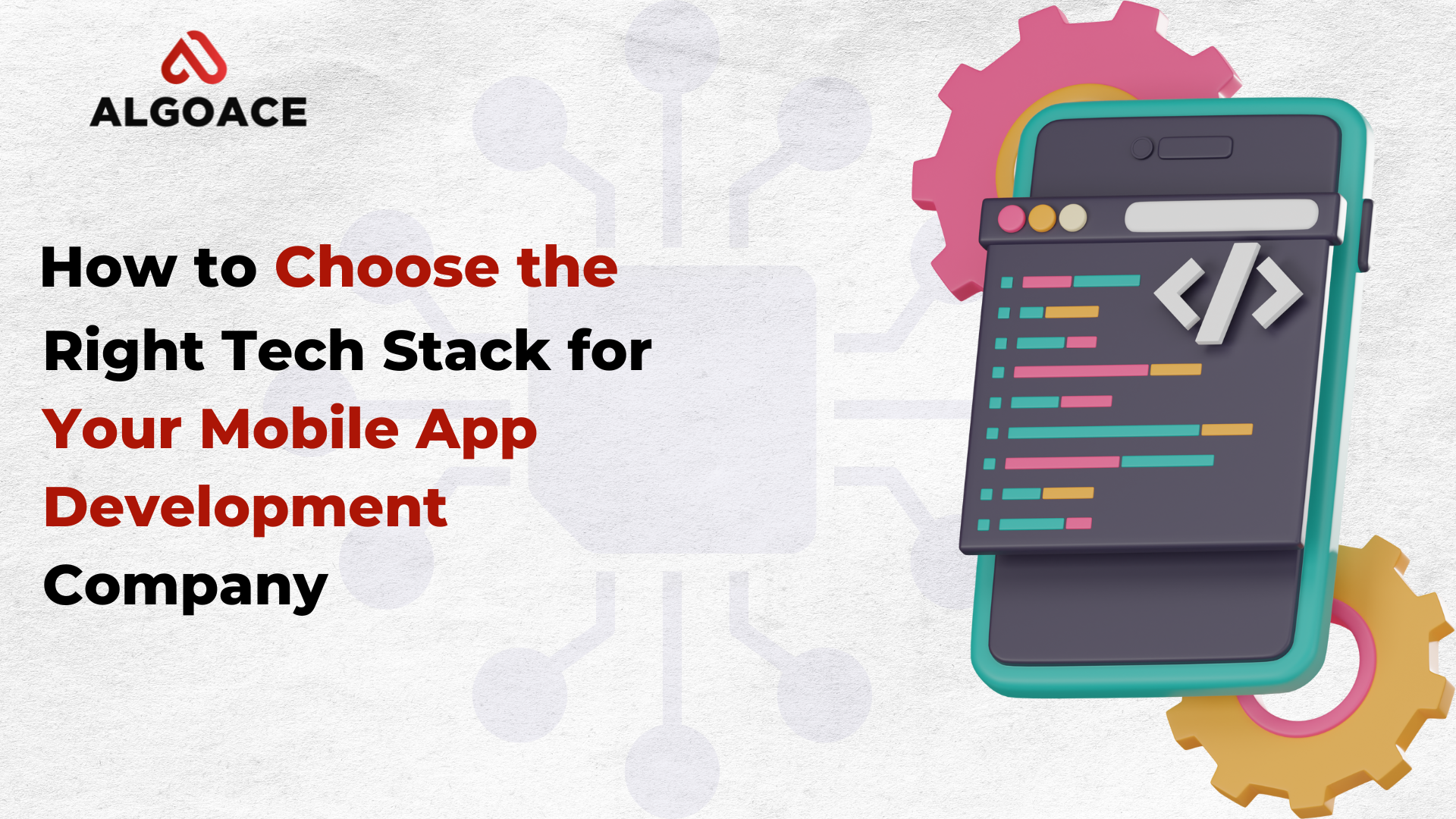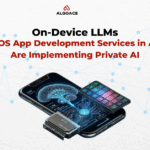
It’s important to pick the right tech stack for your mobile app development company. Similar to building a house, you need a solid foundation for stability and long-term success. Performance issues, scalability issues, and higher costs can all result from using the wrong technology stack. This article will direct you through the most common way of choosing the best tech stack for your versatile application, guaranteeing you settle on informed choices that line up with your venture objectives.
Also Read: Unveiling Algoace: Pioneering Success as a Premier Software Development Company
Understanding a Tech Stack
A tech stack is a set of technologies used to build and run an application. Frameworks, servers, databases, libraries, programming languages, and tools are all included.
What Makes Up a Tech Stack?
- What users interact with is the front-end or client-side.
- Back-End (Server-Side): This part takes care of things like authentication and database interactions.
- Information base: Stores every one of the application’s information.
- Improvement Instruments: IDEs, rendition control frameworks, and so on.
Types of Mobile Apps
There are 3 main types of mobile apps:
1. Native Apps
Native apps Using platform-specific languages (Swift for iOS, Kotlin for Android), native apps are developed for iOS or Android. They offer the best execution and client experience however require separate advancement for every stage.
2. Hybrid Apps
Hybrid applications run inside a native container but make use of web technologies like HTML, CSS, and JavaScript. They strike a balance between speed of development and performance.
3. Web Apps
Web apps are accessed via web browsers and do not require device installation. Although they may lack native apps’ performance and user experience, they are simpler to develop and maintain.
Factors to Consider When Choosing a Tech Stack
There are some basic factors considering choosing Tech Stack:
1. Project Requirement
Learn about the particular requirements of your project. What essential features are there? Do you require extensive data processing, offline functionality, or real-time capabilities?
2. Target Audience
Think about who will use your app. What operating systems and devices are they using? This can impact whether you pick a local, crossover, or web approach.
3. Budget Constraints
Choosing a technology stack can have a significant impact on your budget. Because separate codebases are required, native development can be more expensive.
4. Timeline
On the off chance that you’re on a tight timetable, a few innovations and structures can accelerate improvement. For instance, hybrid apps may be developed more quickly than native ones.
Front-End Development Technologies
Front-end improvement innovations center around making the UI and guaranteeing a consistent client experience. Famous advancements incorporate Respond Local for cross-stage applications and Quick for local iOS improvement.
Overview of Front-End Development
The part of the app that users interact with is the primary focus of front-end development. It involves creating the user interface and making sure that the user has a pleasant experience.
Popular Front-End Technologies
- React Native enables the development of mobile applications. It is well-liked due to its effectiveness and performance.
- Flutter is Google’s UI toolkit for creating single-codebase applications that are natively compiled for desktop, mobile, and the web.
- Swift is a programming language for iOS applications. renowned for its efficiency and cutting-edge syntax.
- Kotlin is the language of choice for developing Android apps due to its efficiency and modern features.
Back-End Development Technologies
Back-end improvement advances handle the server-side rationale, data set communications, and application mix. Due to its real-time capabilities and Django’s rapid development and clean design, Node.js and Django are popular choices.
Overview of Back-End Development
The back-end resembles the driving force of your application, dealing with information handling, stockpiling, and guaranteeing everything works in the background.
Popular Back-End Technologies
- Node.js: Known for its event-driven architecture, which makes it perfect for applications that need real-time data.
- Django: A significant level Python structure that empowers quick turn of events and perfect, practical plan.
- Ruby on Rails: Known for its speed of development and simplicity.
- Firebase: It is a Backend-as-a-Service (BaaS) platform with an easy-to-use authentication system and a real-time NoSQL database.
Databases
To efficiently store and manage an app’s data, databases are necessary. SQL databases like MySQL, which store structured data, and NoSQL databases like MongoDB, which store data in a more adaptable way, are two common types.
Importance of Choosing the Right Database
The data set is vital as it stores every one of the application’s information. Performance and scalability are affected by choosing the appropriate one.
Types of Databases
- Structured query language (SQL) databases like MySQL and PostgreSQL are examples. They are ideal for complex queries and structured data.
- NoSQL Data sets: Non-social data sets like MongoDB and Firebase, are ideal for unstructured information and versatile applications.
APIs and Integration
APIs empower different programming frameworks to communicate and share information, improving a mobile app’s functionality. Your mobile app services can gain valuable features and streamline processes by successfully integrating APIs.
Role of APIs in Mobile App Development
APIs make it possible for various systems to communicate with one another. They make it possible to connect your app to third-party services, which makes it more useful.
Choosing the Right APIs
Make sure the APIs you choose are dependable, well-documented, and well-supported by the community. Consider SOAP for more intricate and secure integrations and RESTful APIs for their simplicity.
Security Considerations
In order to safeguard user data and maintain trust, security considerations are essential. Your mobile app can be protected from potential threats by putting best practices like encryption, strong authentication, and regular updates into place.
Importance of Security in Mobile Apps
Securing your app is essential in light of growing cyber threats. A break can prompt information misfortune, monetary harm, and loss of client trust.
Best Practices for Ensuring Security
- For all communications, use HTTPS.
- Put in place robust authorization and authentication mechanisms.
- Patch and update your software frequently.
- Secure sensitive information.
Scalability
Scalability guarantees that your mobile app will be able to handle growing numbers of users and data volumes without sacrificing performance. The key to supporting growth in the future is selecting technologies that are scalable and creating a sturdy architecture.
Why Scalability Matters
Scalability guarantees that your app can handle more work or more users without sacrificing performance.
Choosing Technologies that Scale
Choose technologies that are known for being scalable. For scalable applications, for instance, Node.js and MongoDB are excellent choices.
Performance Optimization
In order to provide a better user experience, performance optimization focuses on increasing your app’s speed, responsiveness, and efficiency.
Key Performance Metrics
- Load Time: It is the speed at which your app loads.
- Response Time: It is the speed at which your app responds to user input.
- Crash Rate: The rate at which the app crashes.
- Battery Usage: The amount of power your app uses.
Tools and Techniques for Optimization
- Code minification: It is the process of making your code smaller.
- Apathetic Stacking: Stacking assets just when required.
- Profiling Tools: Tools for profiling include Xcode Instruments and Android Profiler, which can be used to locate performance bottlenecks.
Developer Experience
The ease of use and efficiency of tools and frameworks, which have an effect on productivity and code quality, are all part of the developer experience. Developer experience is enhanced by having access to extensive documentation, community support, and user-friendly development environments.
Importance of Developer Experience
A decent engineer experience can accelerate improvement, decrease mistakes, and make keeping up with the application more straightforward.
Tools and Resources for Developers
Integrated development environments: (IDEs) include Android Studio, Xcode, and Visual Studio Code.
Git is a version control system that lets developers work together and track changes. NPM, Yarn, and other package managers for managing dependencies
Conclusion
Your mobile app’s success is directly influenced by the technology stack you select. By taking into account factors like project requirements, target audience, budget, and scalability, you can make an informed decision. Keep in mind that the appropriate technology stack not only ensures the app’s long-term viability and success but also improves performance and user experience, crucial for any software development company.





 Welcome to Algoace!
Welcome to Algoace!
0 Comments